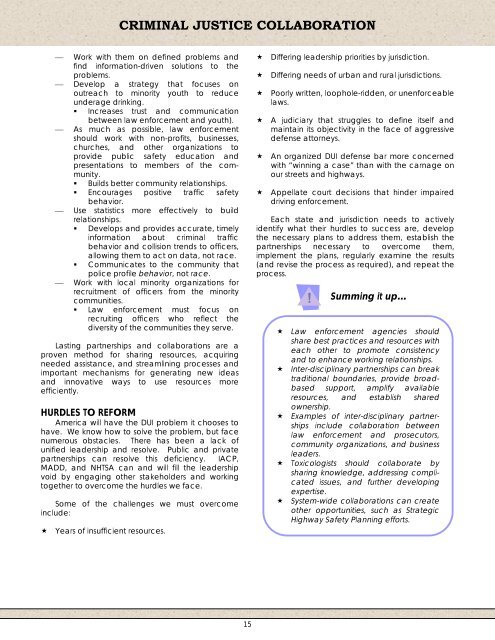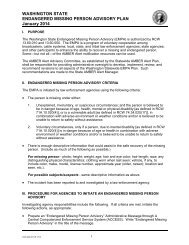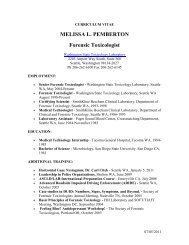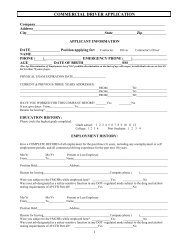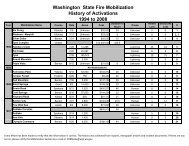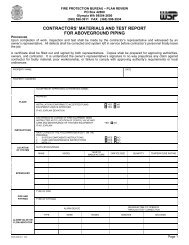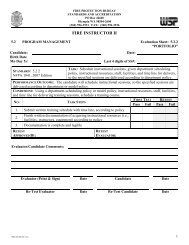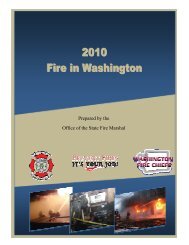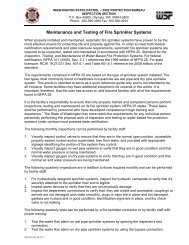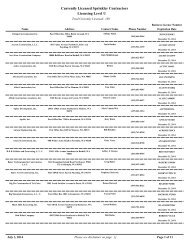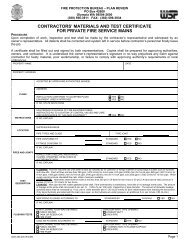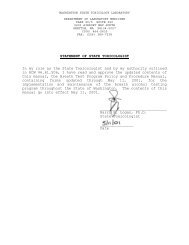CRIMINAL JUSTICE COLLABORATION⎯ Work with them on defined problems andfind information-driven solutions to theproblems.⎯ Develop a strategy that focuses onoutreach to minority youth to reduceunderage drinking.• Increases trust and communicationbetween law enforcement and youth).⎯ As much as possible, law enforcementshould work with non-profits, businesses,churches, and other organizations toprovide public safety education andpresentations to members of the community.• Builds better community relationships.• Encourages positive traffic safetybehavior.⎯ Use statistics more effectively to buildrelationships.• Develops and provides accurate, timelyinformation about criminal trafficbehavior and collision trends to officers,allowing them to act on data, not race.• Communicates to the community thatpolice profile behavior, not race.⎯ Work with local minority organizations forrecruitment of officers from the minoritycommunities.• Law enforcement must focus onrecruiting officers who reflect thediversity of the communities they serve.Lasting partnerships and collaborations are aproven method for sharing resources, acquiringneeded assistance, and streamlining processes andimportant mechanisms for generating new ideasand innovative ways to use resources moreefficiently.HURDLES TO REFORMAmerica will have the DUI problem it chooses tohave. We know how to solve the problem, but facenumerous obstacles. There has been a lack ofunified leadership and resolve. Public and privatepartnerships can resolve this deficiency. IACP,MADD, and <strong>NHTSA</strong> can and will fill the leadershipvoid by engaging other stakeholders and workingtogether to overcome the hurdles we face.Some of the challenges we must overcomeinclude: Years of insufficient resources. Differing leadership priorities by jurisdiction. Differing needs of urban and rural jurisdictions. Poorly written, loophole-ridden, or unenforceablelaws. A judiciary that struggles to define itself andmaintain its objectivity in the face of aggressivedefense attorneys. An organized DUI defense bar more concernedwith “winning a case” than with the carnage onour streets and highways. Appellate court decisions that hinder impaireddriving enforcement.Each state and jurisdiction needs to activelyidentify what their hurdles to success are, developthe necessary plans to address them, establish thepartnerships necessary to overcome them,implement the plans, regularly examine the results(and revise the process as required), and repeat theprocess.Summing it up… Law enforcement agencies shouldshare best practices and resources witheach other to promote consistencyand to enhance working relationships. Inter-disciplinary partnerships can breaktraditional boundaries, provide broadbasedsupport, amplify availableresources, and establish sharedownership. Examples of inter-disciplinary partnershipsinclude collaboration betweenlaw enforcement and prosecutors,community organizations, and businessleaders. Toxicologists should collaborate bysharing knowledge, addressing complicatedissues, and further developingexpertise. System-wide collaborations can createother opportunities, such as StrategicHighway Safety Planning efforts.15
COMMUNICATIONINTERNAL COMMUNICATIONHow do we sell DUI enforcement to our officersand the public? As with any good product, it largelysells itself if the target audience is made aware of it.Garnering the support and response of officers andthe public requires leadership, which begins withawareness and commitment at the highest level ofany organization. Motivating road officers to notonly accept, but also become actively involved withDUI enforcement, should be one of the focal pointsof a progressive traffic enforcement program. Thismotivation begins with the chief, sheriff, or otherdepartment head and must be conveyed from thetop down throughout all levels of the organization.Training Officer apathy can be a concern when trying topromote DUI enforcement. This apathy canresult from a lack of training, so it is essential thatall officers receive the most current trainingavailable in DUI and other traffic enforcementtechniques, including standardized field sobrietytesting (SFST). It seems that many officers fear ridicule if theyincorrectly enforce traffic laws. Training thatimproves their professional competence is amotivational force for most. Internal train-the-trainer programs can be a veryeffective means to promote traffic enforcementtraining, as officers often better accept andimplement training that is provided by trainersthat they know.The Value of Statistics Provide officers and the public with statistics onDUI collisions, including the number of deaths,medical expenses, and property damageinvolving impaired drivers. Such statistics arereadily available from a variety of sources,including the National Highway Traffic SafetyAdministration (<strong>NHTSA</strong>), state governors’ trafficsafety offices, and MADD. See, for example,www.nhtsa.gov, www.stopimpaireddriving.org,www-nrd.nhtsa.dot.gov/departments/nrd-30/ncsa/, www.ghsa.org, www.madd.org. In addition to being used to educate officersand the public, data should be used as part ofany management accountability model toensure resources are used in the right place andat the right time to interdict impaired drivingbefore crashes occur. Law enforcement executives who seek publicsupport for their enforcement efforts may alsocompile local statistics of the cost in life andproperty to their community. When citizens aremade aware of the personal costs to them inhuman life and injury, along with monetary lossthrough medical expenses and propertydamage, they are likely to support your efforts. Even if citizens are not directly involved in a DUIcrash, they are affected by an increase in theirmedical costs and vehicle insurance rates.These statistics are the foundation of support forboth law enforcement officers and the publicthey serve.EXTERNAL MESSAGINGWorking with the public is a must in DUIenforcement. Law enforcement executives shouldnot be deterred by the occasional negative publicresponse to impaired driving enforcement. Aconsensus of the vast body of research on publicattitudes continues to show that the public ratesimpaired driving among the greatest highway safetythreats and there is broad-based support forenhanced enforcement. DUI enforcement programsare greatly enhanced when an agency isproactive in garnering support for its efforts from keysupporters and allies such as MADD and other trafficsafety organizations, community groups, andcoalitions.Public Relations A key component to an effective DUI enforcementcampaign is proactive public relations.Civic and community groups are often eager tohave police officers and executives makepresentations on traffic and crash-related topics.These opportunities are invaluable in securing abroad base of community support, not only forthe traffic and DUI enforcement programs, butfor the agency in general. These presentations should focus not only on safedriving behaviors and the importance of drivingsober, but should also emphasize theenforcement effort. Public perception that strictenforcement is occurring is one of the mosteffective means of reducing driver behaviorsthat contribute to traffic crashes. Recent analysis and study of traffic safetycampaigns has demonstrated that clear andconcise messages about strict enforcement aremore effective at eliciting the desired publiccompliance than are messages about theinherent safety benefits of that compliance.When combined with actual high visibilityenforcement, these messages have a synergistic16


